There has been a mini-wave of “what’s it all about?” posts from some of my fave people in learning tech of late. Kicked off by Audrey Watters understandably reaching The End, fed by disheartening and disappointing developments, profit-seeking corporatism solidifies its grip on everything to do with technology in education.
It gets harder to find the bright spots, but a few longtime battlers are doing their best. Maybe they are “trapped in a story that will never get them to ‘better’ because the foundations will always be rotten”. But I appreciated Jim’s Thinking about Edtech, “as an approach that is exploratory, experimental, and creative, not to mention generous and unbolted to the logic of licensing and litigation.” And Tom Woodward planting punching lions in the face as a solid metaphor for why some of us keep going, perhaps in futility. As she always does, Anne-Marie Scott writes thoughtfully and affectingly about how “techno-bullshittery never ceases, and the lack of respect for learning and teaching expertise and for human scale initiatives is unrelenting” but also advising that “in the face of whatever monstrous bullshit, find your people, do good work at whatever scale you can, and find ways to share that out.”
So, this blog post… I don’t blog enough, and that’s because I make the posts too big in my head. Sometimes they spiral out and then gather mould in my drafts folder, too often I just don’t know how to frame things in a constructive or useful way, and don’t want to waste people’s attention with pointless venting.
Some of us have ranted before about how controlling the platform is undervalued by educators, and too often by learning technologists as well. Seeing the vast and malignant effects of the for-profit platforms defining our lives, it is vexing that educators don’t seem to want something better for ourselves. But rather than polemic, I’d like to express the value of an open platform that we support here at TRU via the most convincing form of argument I can think of, which is sharing some work it allows our community to do.
Our core WordPress Multisite platform here is called Trubox, and most of what I intend to share lives there. I’m not going to say much about its non-identical twin platform for the OpenETC, at least not now… But the structure of both platforms is almost identical: hosted on BCNet Educloud, tended and watched over like a hawk by our Innovations Developer Troy Welch. Troy manages the server nodes, the applications, the themes and plugins, and if he says “no” to one of our constant plugin or setting requests he always has a detailed and sensible explanation that is informed by his decades as a university instructor.
Trubox was born while sitting at my kitchen table with Alan Levine, and that was just one of many transformative and enduring contributions that he made to Thompson Rivers University during his Open Learning Research Fellowship. As of today, Trubox hosts 1569 sites (1255 of them public) and 1714 user accounts. We made the decision not to integrate the platform with our university’s single sign-on, in part because we did not want to make it harder to add people from outside TRU, and we didn’t want people to lose their access if they graduated or otherwise left. We have whitelisted TRU faculty, staff and student email addresses so people can sign up themselves, and they can start new sites from a number of pre-themed and configured options.
I hope to say more about our philosophy and approach towards Trubox and the OpenETC multisites in a follow-up, but for now will focus on the many ways this platform works for the Learning Technology & Innovation team and the communities we serve. Honestly, LT&I could not function as we do without it, and I don’t know how other learning tech units get by without their own open platform.
There are going to be a LOT of sites listed here, and I hope the effect isn’t numbing for you. But the message is in the multiplicity of use cases, and how the work in one area informs others. There is some clever development work and examples of snazzy design coming up, and a lot of thought and care, but the majority of these examples are not technically complex and could be supported by many learning techs in many places. What I also hope to capture is how every site that gets built is not just another piece of work that we finish and move on from, but represents new capacity for what we can build on in the future — each new technique we learn, each new site we can clone cascades onto future sites in a virtuous cycle of community innovation. I’m reminded of how Jon Udell used the term “trailing edge technologies” nearly a decade ago, describing them “not as closed products and services, but rather as toolkits that invite their users to adapt and extend them.” I truly think we’ve got that here.
This work is also really, really fun and satisfying to do.
Our own publishing and collaboration needs
Even if we only used Trubox solely for internal needs of the LT&I team, it would be an essential platform for us.






Some of our team sites:
TRU Digital Detox: Brenna Clarke Gray has posted brilliant essays on making our relationship with tech less toxic for three years running now. I love how the site archives each retain the different visual themes of each year’s Detox. This site functions more or less like a newsletter, using a simple bulk email plugin.
Moodle Orientation: developed by Jamie Drozda and Amanda Smith, the site shares tutorials and how-to’s focusing on the most common questions that we get from our users. Having it on Trubox means specific materials can be shared with anyone via a direct hyperlink. This site has saved us untold hours of effort and anticipated countless Moodle support requests.
Learning Without Walls: this was necessitated out of the pivot to virtual delivery. It allowed us to collect student-focused learning tech resources as well as to partner with our colleagues in other student service roles across the university.
Teaching Unbound: between workshops and the flood of support requests, we were generating a lot of materials during the pivot. Utilizing the excellent BetterDocs plugin, we did our best to collect what we were sending out to our community. Again, this greatly reduced our effort when responding to support requests, and gave our community a reference they could look to on their own. We also were able to share out resources from our wonderful Open Learning Instructional Designers and the Centre for Excellence in Learning and Teaching (CELT). We’ve run a partner site at Workshops without Walls to promote sessions, handle registrations, etc.
Lightboard! is our fab video producer Jon Fulton’s site demonstrating and supporting the DIY marvel that he built.
Workshops
We frequently use Trubox as a platform for our workshop materials. One of our mantras when we develop programming is to “create a persistent resource” that is accessible on the open web. Even when we don’t polish every detail and the site itself is a little raw, it can provide a starting point to generate more formal resources later. It also keeps our work visible to each other and to our community, and that practice frequently generates ideas in itself. A sampling:
Visualize This!: From Marie Bartlett and Jason Toal (we miss him). “A gallery space for a series of workshops and studio sessions about using visuals for teaching, learning and scholarly activities.”
Memes and GIFs: this is a workshop I periodically do with Brenna and it is almost too much fun. We use SPLOT technology (more on that below) to gather up the memes and GIFs that the participants make.
Technology for Teaching and Learning at TRU is an impressive process from Jamie and Brenna designed to guide online instructors into more mindful practices using tools outside the learning management system, and Life Beyond Moodle offers a fantastic cloneable starter framework for a course site.
We’ve offered a lot of H5P workshops, but I particularly liked this effective session Jamie and Brenna did for ETUG a couple months back, where participants were guided through a hands-on session virtually. These materials are on our Pressbooks server, not Trubox (whatevs). While I’m at it, I’d be remiss not to link to Brenna’s outstanding H5P-fied edition of the open textbook Writing for Success on the BCcampus Pressbooks site.
Podcasting
One of the amazing things that Brenna brings to our team is next-level podcasting ability. It’s a running joke that I am terrified that the CBC or some other outfit will poach her from us, except I am not joking. She is a co-investigator on the SSHRC-funded Amplify Podcast Network project, and her production and on-mic skills never fail to wow me.






You Got This! is Brenna offering “weekly episodes offering tips, advice, insights, and conversations with folks from across our campus community.” Over these 32 engaging episodes emerges a fantastic overview and insight into the work of so many educators across TRU.
Knowledge Mobilization and You: Scholarly Podcasting for the Whole TRU Community is one of the first podcast workshops Brenna developed here, along with Jon, covering scholarly and cultural dimensions of podcasting as well more practical elements like gear, recording, and editing.
Introductory Podcasting Masterclass at TRU: A Self-Directed Exploration of Scholarly Podcasting is a more structured course which can be taken as a cohort or as a self-directed study. This iteration covers techniques and also guides participants through the process of developing and launching a project. I’m not aware of anything quite like this, and I love it! The open virtual discussions during live sessions that Brenna leads have been so fun.
A few of the podcasts from the wider community on Trubox:
Eye on EDI: “an anti-racism podcast that unpacks equity, diversity and inclusion through educational conversations” from Amna Qazi.
Peers on Careers: TRU student Career Ambassadors “talk with peers and professionals to explore different career paths and ways to prepare for life after graduation.”
Torts Podcast: from Faculty of Law professors Katie Sykes and Ryan Gauthier.
Open Learning
OL is TRU’s open and online distance learning division, serving the open learning needs of British Columbia. Most courses are continuous entry, students can register anytime, work at their own pace. Over time Trubox has emerged as an essential platform for extending what OL does.






Thompson Rivers University’s Kamloops campus is on the traditional lands of the Tk’emlúps te Secwépemc within Secwépemc’ulucw, the traditional and unceded territory of the Secwépemc people. Learn Secwepemctsín Online is an introduction to the basics of Secwépemc sounds, introductions and greetings. I just love the design and effective use of audio on the site.
We often use Trubox for courses that have a lot of content, and that demand more creative and effective presentation of the materials than what is typically available in Moodle. Many of these sites are password protected, sadly, but GEOL 1111 SW6 Introduction to Earth Science is one example.
GERM 1111: Introductory German 1 is a fantastic combination of WordPress, H5P and simple audio and video deployment, with some typically delightful graphic touches from our brilliant designer Nicole Singular. What I particularly like about this example is that after some initial support, the subject matter expert eventually felt comfortable enough with the tools to build a lot of the materials himself.
BIOL 3021: Community and Ecosystem Ecology is a cool initiative as it allows students to share work and interact even though the course is independent study. The site is structured for students to share the steps of their research project — some nifty work by multimedia developer Stephanie Gountas here to develop a simple sign-up process that makes the site zero fuss to manage.
GEOG 2221 – Regional Geography of Canada – another site extending and connecting a continuous enrollment online course. Students are asked “What can you buy for $713,000 in your community?” (the average home price in Canada in 2021 – this figure has gone up a lot since the exercise was first launched). A nice integration of a mapping tool. The responses over time are always a fascinating reference.
The TRU Learning Design Framework documents OL’s “learner centered approach, grounded in the principles of openness and flexibility”, the “design framework represents our shared values, and was designed based on evidence and research related to open and distance learning practices.”
SPLOT!
SPLOTs were another amazing outcome of Alan Levine’s time here. He’s not only kept building and improving them, but blogging about them too (238 posts and counting). An acronym in search of meaning, SPLOT stands for something like “Simplest Possible Learning Online Tool”. They usually involve form-based authoring, are intended to be as simple as possible not only for authoring but for managing as well, and they require no personal information from the user.
SPLOTs are perfect for shared course blogs, or anytime you want to set up a quick site to gather resources with little fuss from a group of people. The most popular SPLOT starter sites are in the Clone Zone for both Trubox and the OpenETC, so people can whip up their own SPLOTs, or we can do it for them in just a few minutes. SPLOTs are a learning technologist’s dream tool if only for how easy they are to support. A few Trubox examples:

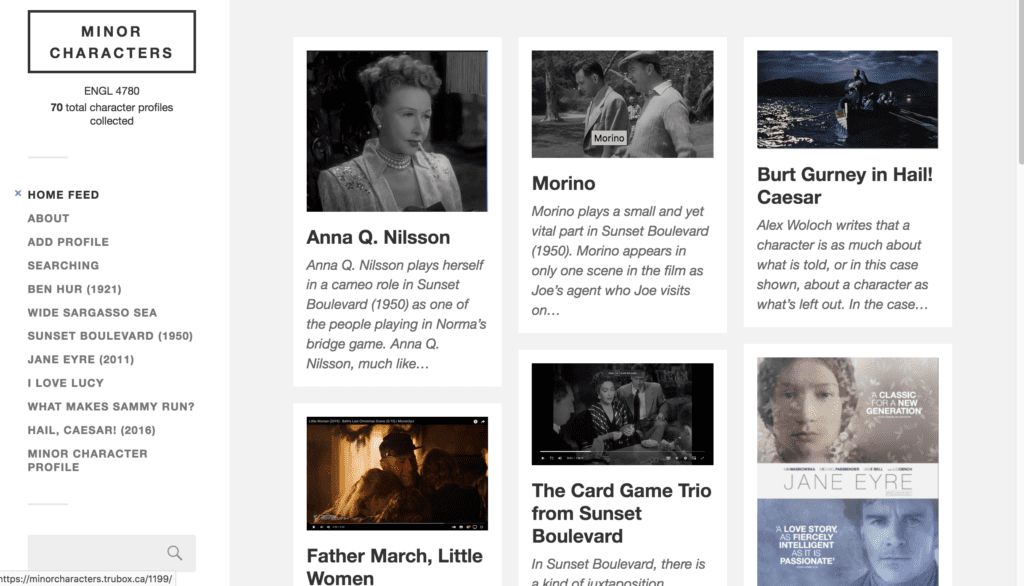


Salmon in the Tree is “students researching and answering a current biological question using academic sources of information, where the questions have an evolutionary, ecological or diversity theme.”
Minor Characters is a great example of using the TRU Collector theme as a single assignment within a larger course.
Travel Media features four years of fantastic videoblog projects for Kathleen Scherf’s Tourism course.
CAISSIE – when faced with a lack of open resources for critiquing images on CAISSIE (capitalism, gender, history of seeing, images for professions, mass media, globalization, the future), professor Terryl Atkins sent students out to photograph and share their own.
Supporting student research and open pedagogy
I think of SPLOTs as an on-ramp to getting students onto the open web with low risk and minimal hassle. We’re always extra-excited to support student research from myriad projects with more specific needs. While we provide training, tech assistance, and occasional design help, in most cases these sites are built by the students themselves. So in addition to mobilizing and extending their research, they are building and demonstrating their digital literacies (which extend past WordPress and into things like copyright, accessibility, etc).
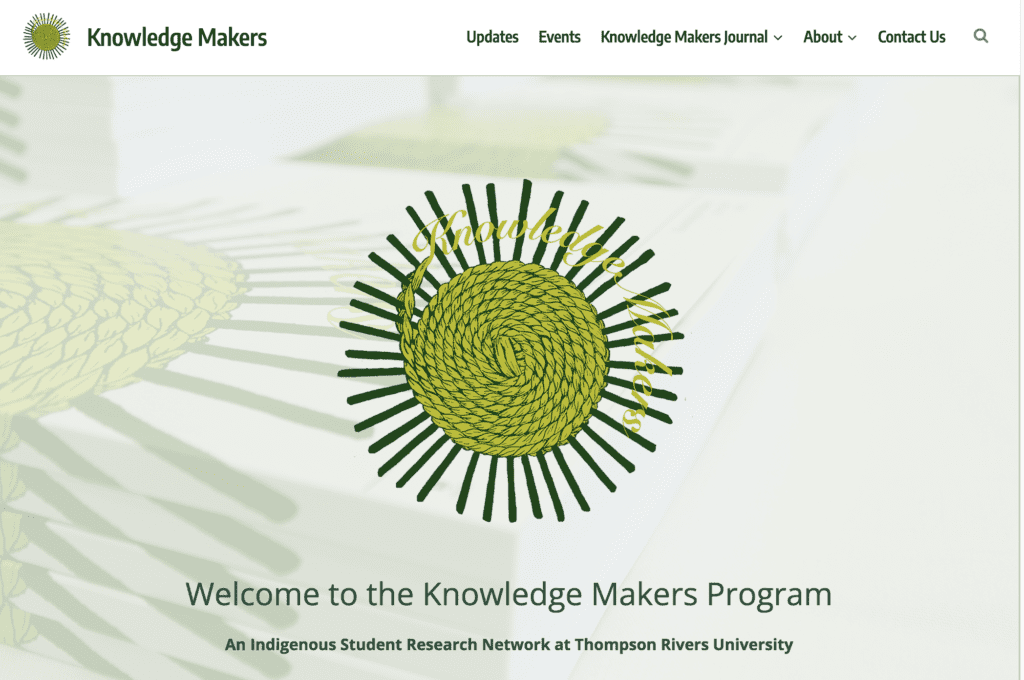




Knowledge Makers, an indigenous student research network, is one of the most impactful projects I have encountered at TRU. The researchers are guided through an immersive and rich process “with the support of our families, Elders, administrators, faculty, staff, and each other to create something that expresses the importance of being Indigenous researchers, and the breadth and possibilities of Indigenous research methodologies.” The site shares insights into the project, and archives of the resulting volumes published. It has been so moving to follow these researchers along the journey, and it has been an immense amount of fun. Sandra Bandura went through the program as a graduate, went on to coordinate it for a couple years, and has become a Trubox power-user for a number of sites, including her ongoing work as a math instructor. The site she built for her brother Johnny Bandura, highlighting his mural “imagining the lost futures of 215 Kamloops children”, creatively presents his incredible and often heartbreaking work.
CURN: Canadian Undergraduate Research Network: empowering “students to help other students through their own journey, in an open and judgement-free environment.” There is a vast and impressive collection of open resources on all elements of student research here, and we hope it will be adapted elsewhere.
A lot of times, the presentation of student research gets consigned to “ePortfolios”, so I am always pleased to see student work online that foregrounds the work itself in a variety of media:
Mirror Mirror: Navigating the Complicated World of Body Image, “created with self-awareness in mind. We wanted to create a platform that could start the conversation about body neutrality, body positivity, and the effects of COVID-19 on body image.” Includes a podcast, information sheets and H5P activities.
Jusk Ask: Demystifying Consent – “explaining what consent is, how it works, and what to do if something happens to you or someone you know. So breathe deep and exhale slowly.” Interactive book, social media campaign and many other resources.
Caregiver Fatigue: “Caregiver fatigue is more common than anyone wants to admit, and there is a community to support you throughout your challenges.” Audio, video and interactive elements.
ePortfolios:
Many of the sites on both Trubox and the OpenETC are ePortfolios, and used mindfully WordPress can be a fantastic portfolio platform. We rarely toss students into the deep end of a generic “Hello World” site. We prefer to work with the instructor to define the required elements of a desired portfolio, and for each section we embed prompts and models to give the students some idea of what is expected. The students then receive a cloned starter site with recommended theming, configuration and helpful content. We also link to the needed essential technical tips. I like to tell students that even if they just copy/paste the needed responses into the designated areas, they will have met the basic requirements of the assignment. This usually eases the fears of the most technophobic participants. However, we also make it understood that they are welcome to change the themes, restructure the site, etc… if they feel confident and motivated. In my experience, about half the students do.
And unlike when students use an off-the-shelf proprietary portfolio tool, they are building skills using a widely-used web authoring platform, and they maintain control of the site after they finish the course or leave the university.




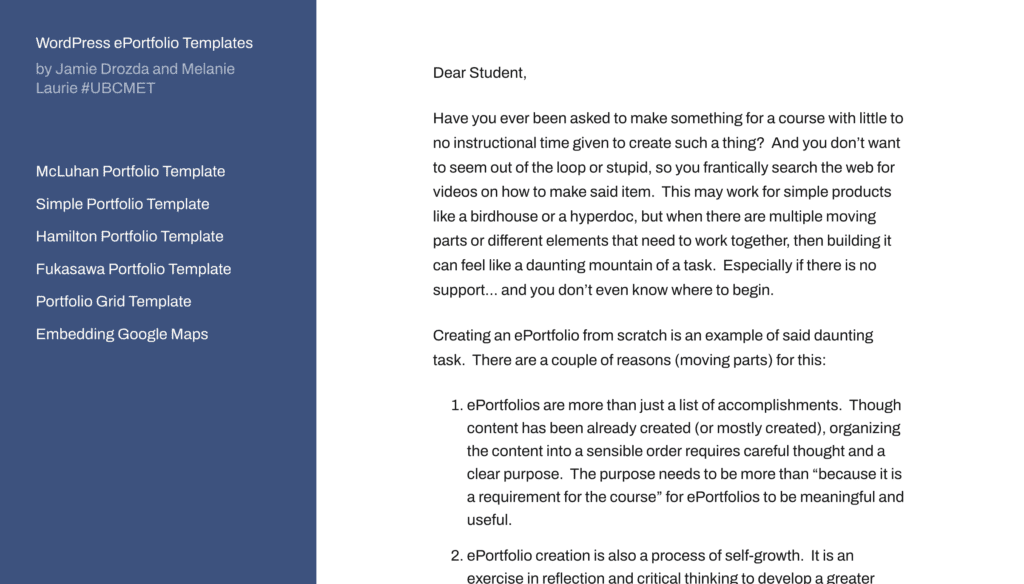
WordPress ePortfolio Templates is a fantastic piece of work by Jamie Drozda and Melanie Laurie. These six diverse cases are the foundation for most of our portfolio starter sites, and these templates are in the Clone Zone ready to run on both Trubox and the OpenETC for students or instructors whenever they choose. I love the “letter to students” that frames this: “The goal of the WordPress ePortfolio Templates is to make the theoretical practical. It aims to take all the positive theoretical underpinnings of ePortfolios and pair it with technical web design instructions so that any student can create a unique ePortfolio without an insurmountable amount of effort, expertise, or expense. It brings the focus back on showcasing you and your work. You can do this!”
The TESL portfolio template by Brenna and the Public Relations Stream ePortfolio template by Joceline Andersen are excellent examples of how an ePortfolio starter site can be carefully structured to guide the students along. I also dig the starter Brenna built with John Hull, and this resulting site from Alexis shows how it can be made the students’ own.
Iterative co-development with our students
I really got a lesson in just how powerful this approach can be when working with a group of graduating visual arts students on their capstone portfolio sites. After getting a sense of what was needed from professor Don Lawrence, I whipped up a rather boring starter site. And was delighted to see how every single artist took their own site to someplace new:
It was so cool to see Elizabeth Spike, Sophia Dodic, Carol Scholsar, Ashya Cross, Emily Wood, Lyn Richards, Kelsey B, Kalene Michalovsky, Christyn Rebmann and others each not only build sites that were showcases to their fantastic artwork, but to see them build web design skills that will follow them along into their careers.
A few of us were impressed with how Emily Wood had not only designed her site, but the elegant way she had used the Hamilton Theme and tagging to organize her works. Some months later, Jamie drew on that work for a new starter site for artists, which we have subsequently made available to visual arts students. To me, this set of interactions highlights the power of a collaborative open platform — we can assist learners in their journey, subsequently learn from them and build upon what they do, and use that learning to enhance the experiences of subsequent students. How often does that happen with a vendor product?
Cultural Mapping
It is that kind of process, where we are all collaborating with each other in a never-closed iterative loop, which speaks to the real power of an open platform as a true learning environment. Along those lines, I’d like to share one more clone story, which speaks to a power that is mostly yet untapped.





A few years back, Kathleen Scherf came to us with an ambitious idea. She is one of a number of scholars at TRU that have integrated cultural mapping into their practice. We had done one simple enhanced map using H5P with her before, for the Kamloops Art Gallery, but for this project she envisioned something more robust. The activity was for students “to research and tell some stories of citizens who are passionate about local food production, food distribution, food festivals and events, food literacy, building community through food, and food assistance in Kamloops” and to represent those stories in text, video and graphics and have it all structured around a map of the city.
Thomas Sandhoff made excellent work of the Toolset plugin and the Google Maps API and over two years the students created the fantastic resource known as Foodloops that is used widely across the community. An impressive piece of open pedagogy, and satisfying to see. It also was a lot of work for Thomas to do, an amount of work we really couldn’t sustain often. So we wondered if was possible to create a more generic version of the site for future projects. Which he did… and after some recent updates from Stephanie Gountas we offer our community a clonable starter mapping site, with SPLOT-like form-based authoring, which is available to all users on Trubox and the OpenETC. This framework has been adopted a number of times, recently by Professor Naowarat Cheeptham’s Biology class on fermentation, and John Hull’s course where students created tour maps of day trips in British Columbia.
Again, we see how highly-focused “boutique” development can be a driver for more widespread and accessible work by many, which can be an exceptionally economical model. I am hoping we can extend this approach to more of our work, I’d love to share what we have to help others do it too, and more to the point I wish more people elsewhere might think in these terms to share what they do as well.
Why am I doing this to you?
I guess I will stop there. I hope my point isn’t lost in the sheer volume of examples I have been putting forward. Believe me, I could have shared more. I didn’t go into the magnificent site for the new TRU Library Makerspace (largely built by TRU student Kirsten Glass, who I first met through the Knowledge Makers), and when I was reviewing examples I kept stumbling on sites I didn’t know existed, like this by an international student from Mexico City with a passion for rock climbing. These things happen when people can use a platform directly without asking your permission. I’m sure I’m missing examples that I’ll wish I’d included later. I also hope I haven’t been too sloppy in attributing the efforts of the many people who have put their skills to bear in making things happen.
I enjoy celebrating my colleagues. But this isn’t meant as an exercise in self-congratulation. I’m proud to be associated with this work, but believe me I see so many ways it could be supported better. One of the great struggles of the past couple years has been to gather the gumption and focus to do what needs to be done to take this to the next level. And while I work in a place far friendlier to this approach than most, it is just one of many activities that competes for increasingly scarce resources, including people’s time and headspace. Not everyone sees as much value in it as I do.
What I hope comes across is that an open platform is a powerful toolkit that only gets more potent with each additional use. I also know that this approach is not exactly fashionable in learning tech these days. I frequently hear from people who cannot get support for open platforms, or if they do are forced to work within such strict and inflexible conditions that most of the potency is lost.
Sometimes I feel part of a dwindling number of people that want to do this work. But this exercise reminds me that when given the choice many people will see value in a platform that doesn’t exist to extract value from them. I want to do what I can to see more of this, not only at TRU but everywhere. It’s a big reason why we are part of the OpenETC. I hope this post begins to get at describing the “what” and “why”. If you are interested and care about this stuff, I hope you will share your own insights, questions or concerns — either in the comments or via your own spaces and channels. What I hope to get at in two upcoming posts (maybe more) is to address some of the common objections and hesitations that I hear (the “why we can’t”) and go a little deeper into some strategies and responses that we have learned to try to deal with them (the “how”).
And maybe from there, I will try to think about that protean creature called the “learning technologist”, and if we may carve out a useful and more satisfying existence in this increasingly dismal narrative of higher education that is grinding us to bits. I’ll also try to sketch out ways I think we can make this kind of open tech more economical and accessible, particularly to those without resources or much support in their own contexts. The OpenETC will likely be discussed. I’ll try to remember sensible footwear. I may bring my angst.

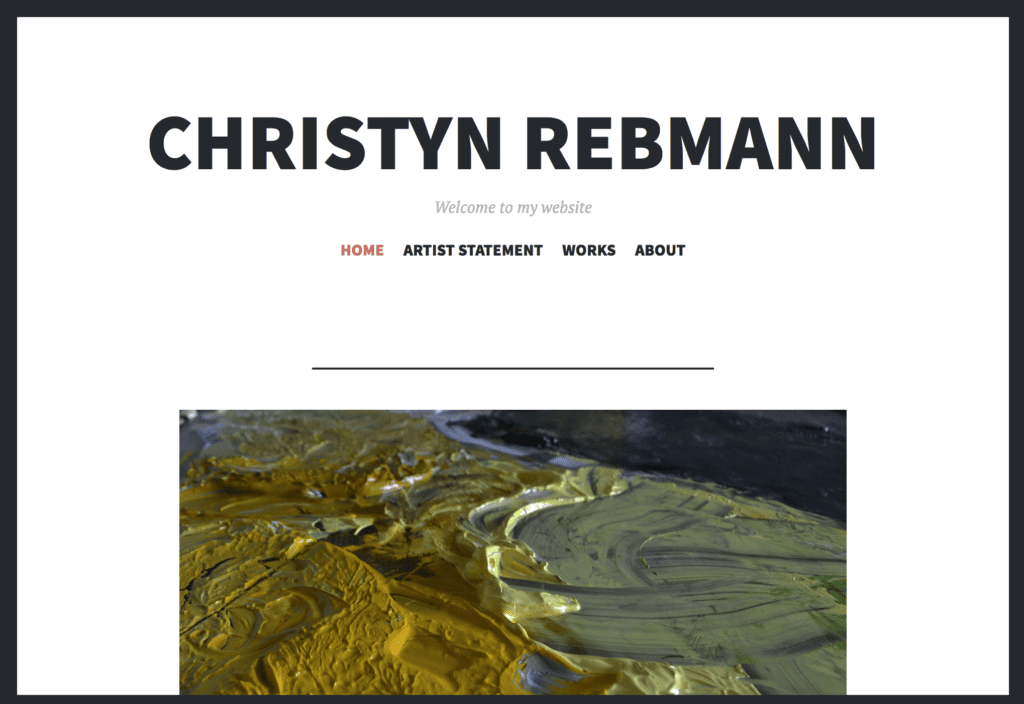
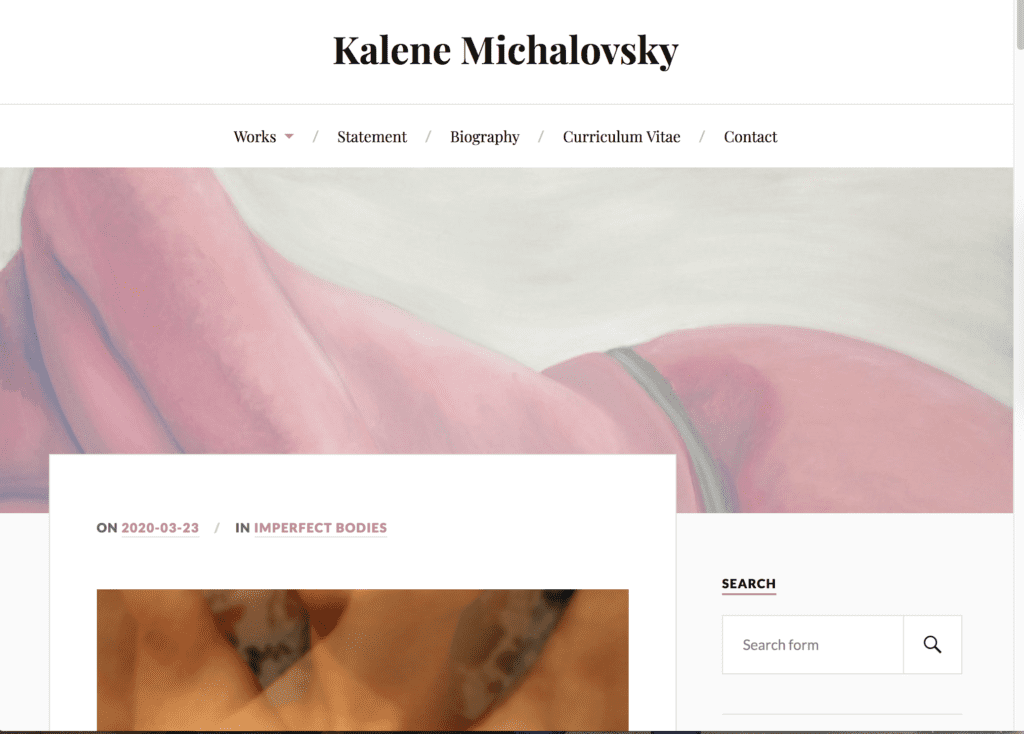
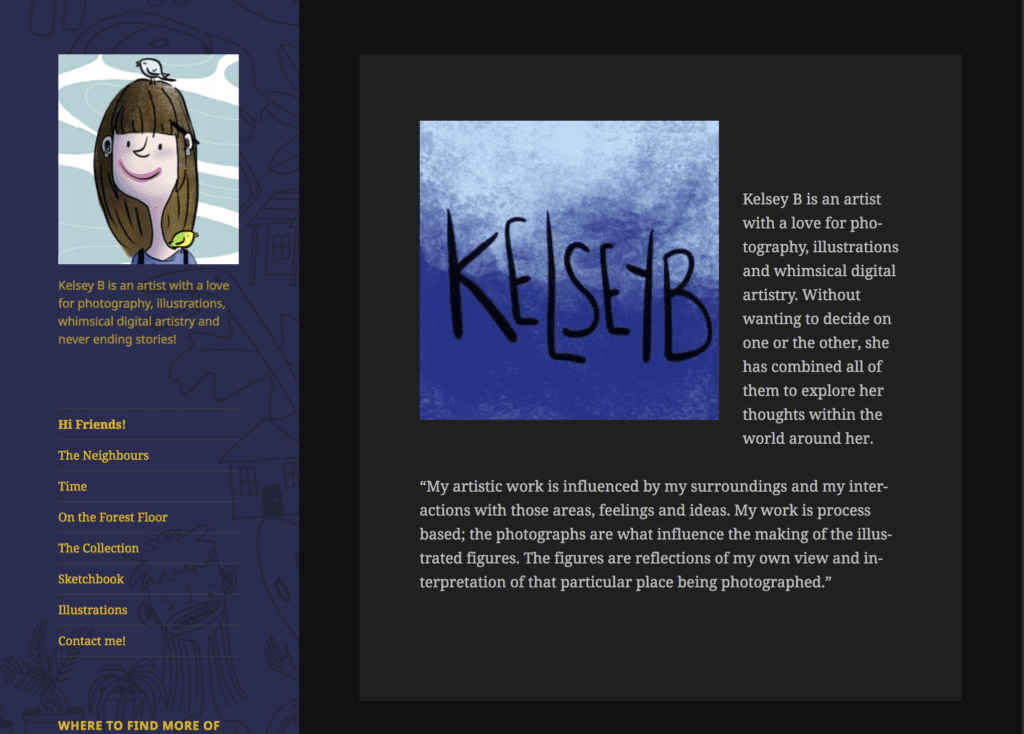
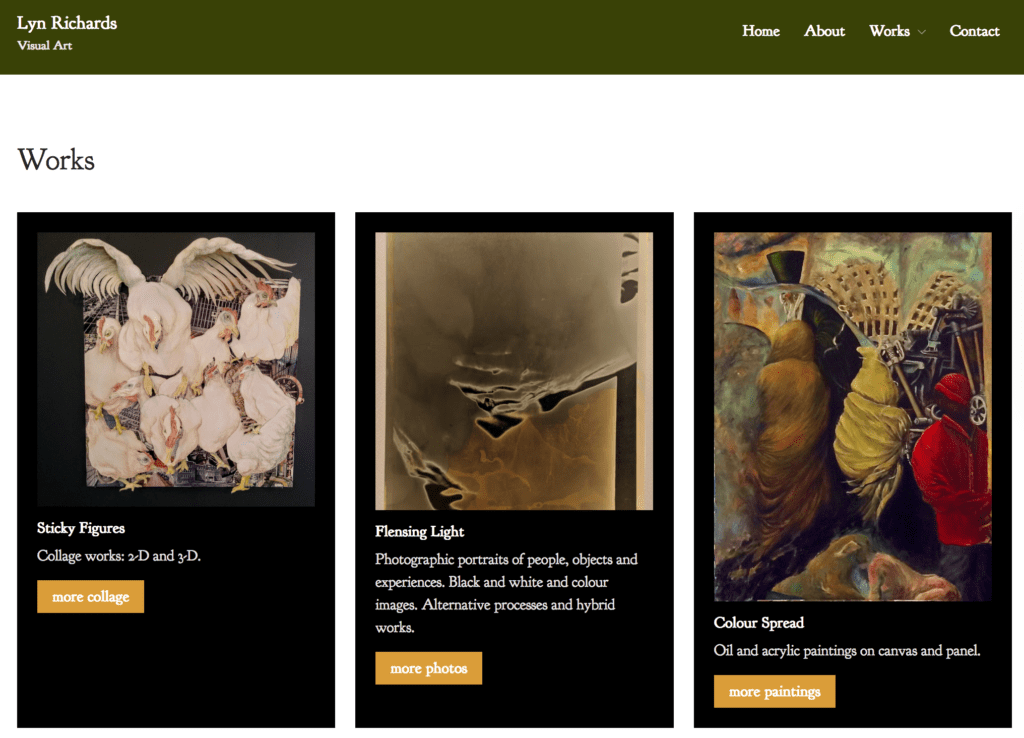
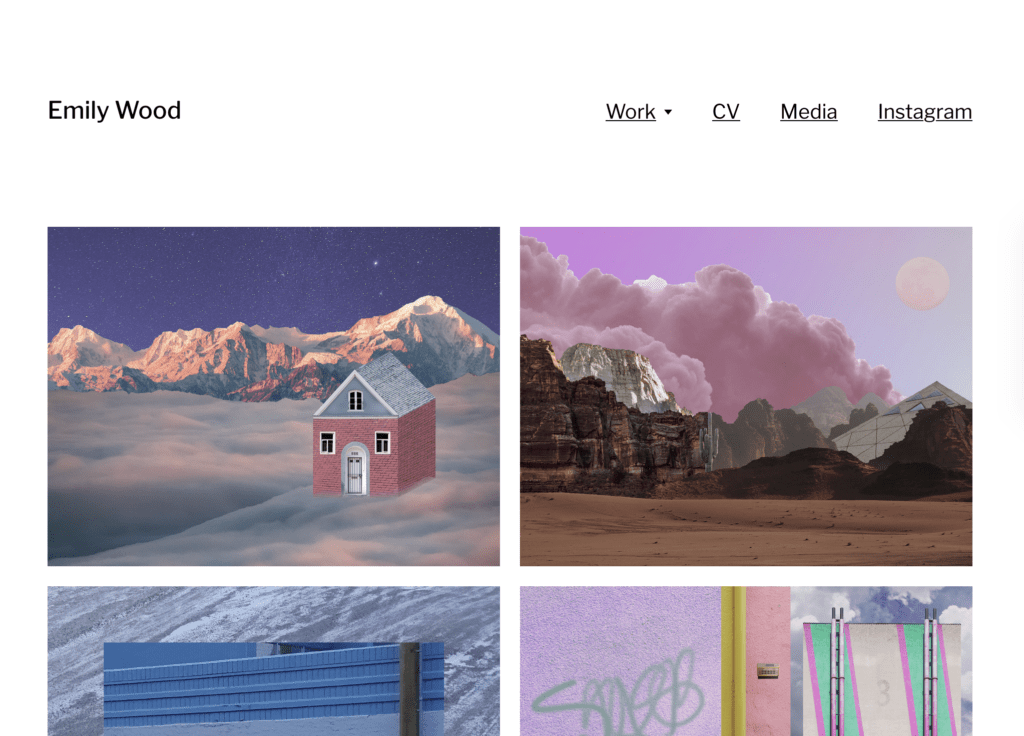
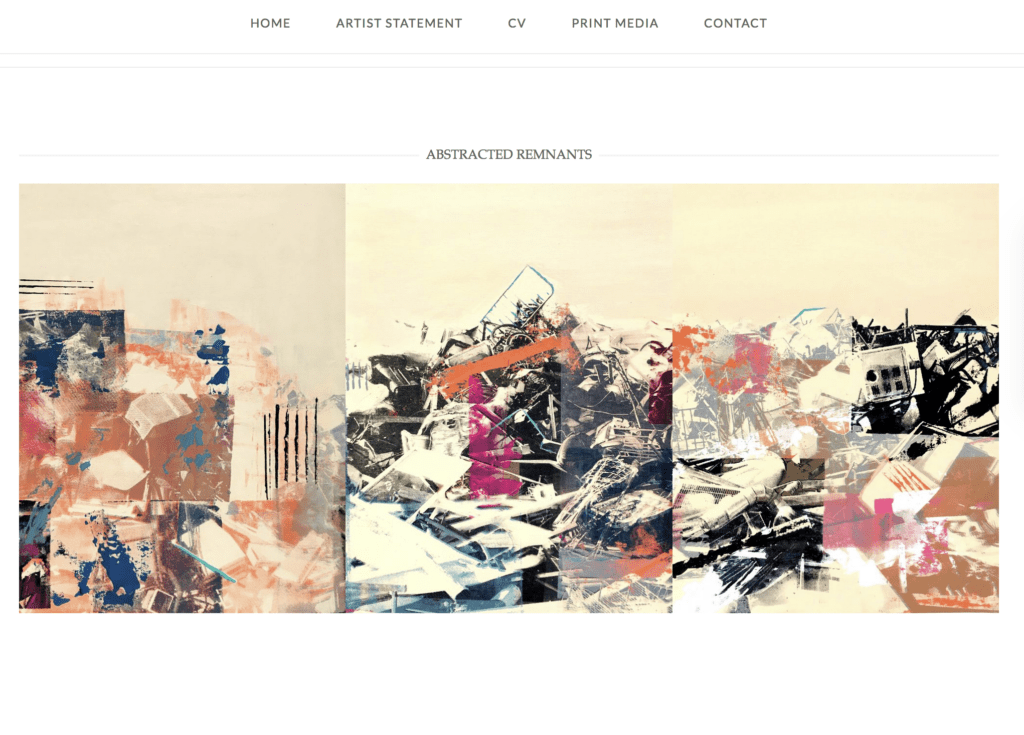
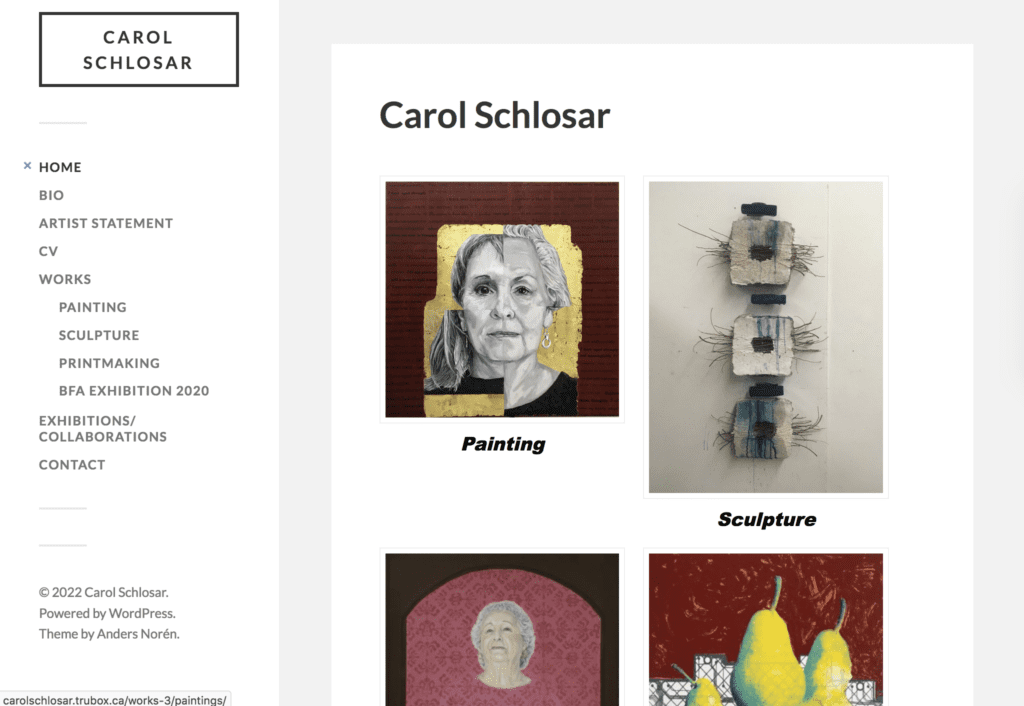
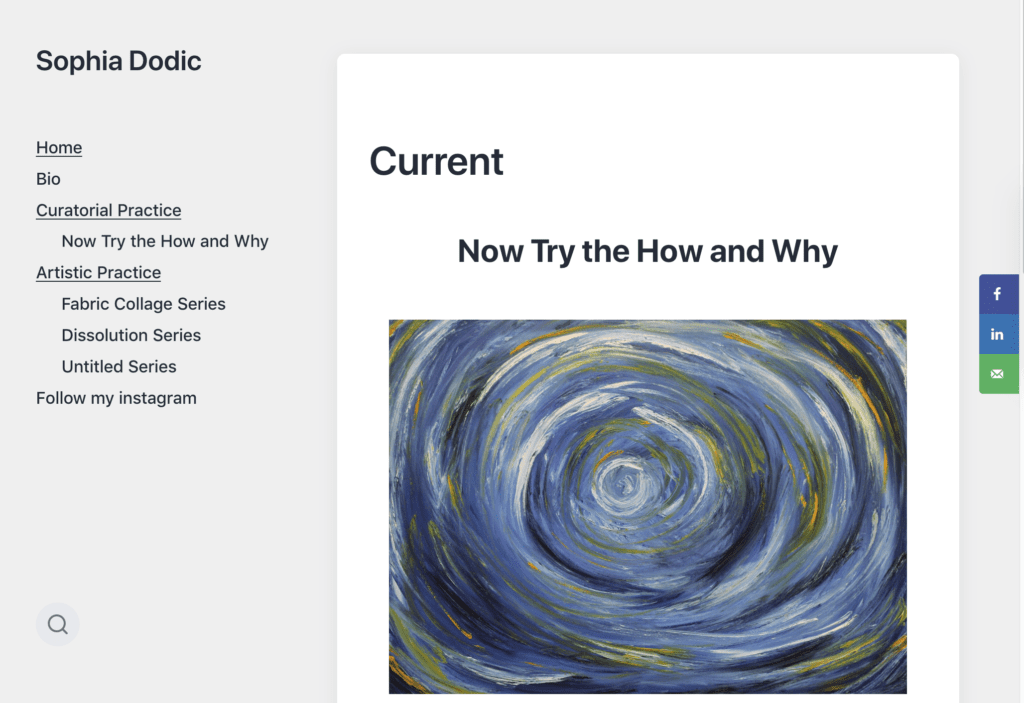
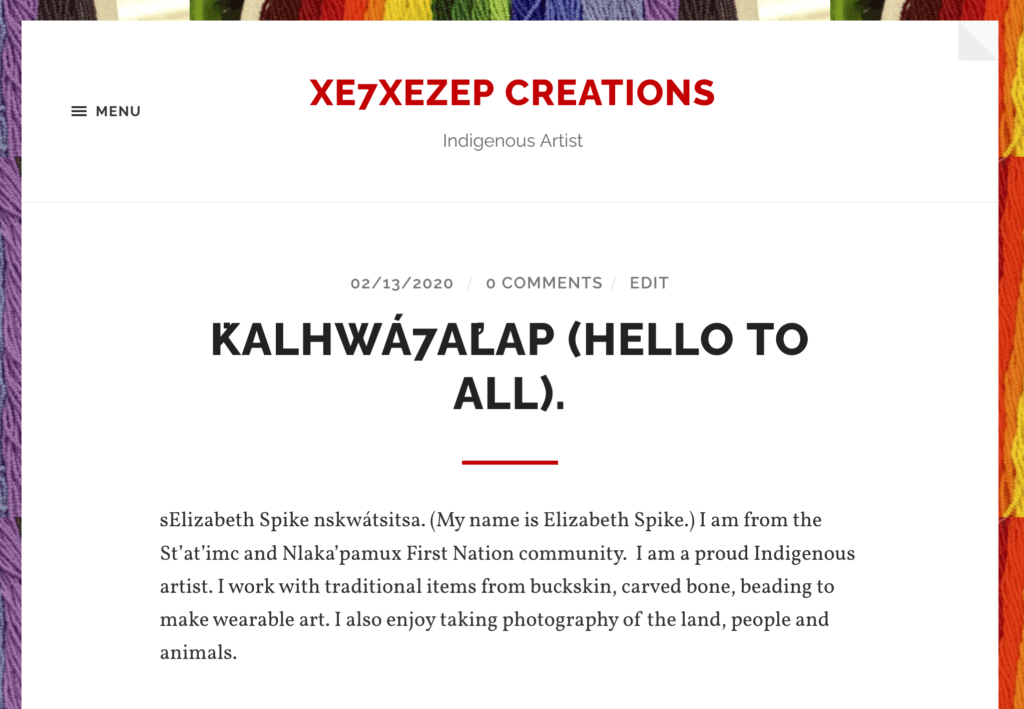
As I already put in a tweet, this post has left me feeling inspired this morning. We are in the process of rebooting/relaunching our web publishing offerings (we have both DoOO and WPMS) and wondering what the future will bring and this reminds me of why the heck I am bothering to invest so much time and energy in it at all.
I need to bug Brenna about the podcasting masterclass. We are thinking about developing something like this for our community and would love to know more.
I’m looking forward to the next posts.
Shannon, I am so excited to hear you are putting some new energy into the UMW open web offerings. I don’t have to tell you how important they have been to our wider community over the years. If you ever feel like comparing notes, I’d be keen to hear what you are thinking and doing. We loved having you at our online sessions and I suspect Brenna will be delighted to hear from you.
I’m just glad to see you not only have a place to do it, but the determination to keep doing the work at all. The former is rarer than it should be, but not a mystery in context or composition; the latter may as well be wholly unknown.
More cogent thoughts later, perhaps.
Hey Chris. There definitely been times where it’s been harder to keep banging. I hope to write a follow up to address some of the tougher parts of this work, not least getting support in the current climate. But ultimately the inspiration of people whose work and thinking I respect has always come through. You among them, I always value your perspective.
Woah it’s like one of those stories of seeds tossed into a field that results in a million flowers. While one acronym we hatched is a silly joke that memory of just spouting out that name “trubox” and saying “let’s do it” is profound among the experiences I had at TRU.
That this list could be so long and very much leaving out easily as much says much about the spirit of creativity at TRU (hey I look down and I’m wearing my TRU t-shirt)— my favorite line here is “These things happen when people can use a platform directly without asking your permission.”
The intertwining overlap with the OpenETC is a beautiful thing to see.
Look who evolved from doom mongering! Blog on.
I really remember that initial set-up process quite clearly (which is not a given with me). You walked me through it but also made me do a lot of the steps myself, because you are a great teacher. And yeah, when we realised we needed a name and URL… you suggested Trubox after about a second’s thought, and I shrugged and we just went at it. Had I known how this thing would go, I might have thought harder. But hell, it works.
Hah, found this, from 40 sites in March 2015 to now! https://cogdog.trubox.ca/2015/03/11/tru-box-by-the-numbers/
That we hatched the idea on a personal reclaim account think (truly) that the TLD domain would be enough to slide it by was so much the spirit
Yep, this is another story of Reclaim Hosting bootstrapping some indie ed tech… and as it started to grow I got a bit nervous that this was living on a self-hosted account. Not least because I am no system admin. I was relieved when we moved to Educloud and became a bit more legit.
Although I appreciated Audrey’s work reading Hacked Education was a constant reminder of all the bad. It is absolutely possible to build access to technologies for learners and academics that don’t rely on data collection, for-profit models, third-party vendors, the vectoralist class, on teaching people to forgo personal safety where personal data is concerned. Your work and the work of countless colleagues is proof of this and it makes me ever optimistic and hopeful.
So thanks Brian for sharing all of the good you and your colleagues are doing, it’s a joy to see and I’m super grateful for it.
Lauren, thanks for reading and for offering that encouragement. You are an inspiration and I always value your thoughts.
Interestingly, Audrey visited TRU early on in my time here, and has always been a real encouraging voice for me. A little while later, I was lucky enough to spend time with her at a small event for indie ed techs (https://abject.ca/la-reclaim-hackathon/ ) and she said to me that rather than obsessing with the wider world of ed tech, open education, etc… that there were real needs at TRU, Open Learning and in the community and that I should focus on them. I’ve often thought about that over the years, and hoped I have lived up to that advice.
I’m probably too prone to seeing people pointing out the bad (especially without offering means of alternative action) as a route to hopelessness. I prefer to build up people’s understanding that there are better alternatives and help people organise to make something that works for them and their community. Seeing other people (like yourself, Anne-Marie Scott, Jim Groom) work in that way gives me encouragement too. I’m very glad for TRU and all of us that Audrey’s advice gave you confidence in the work that you do. And thanks for your kind words as always Brian 🙂
Brian – it takes open leaders like you who encourage us all to “make” what we want -when we want it. Thank you for all your encouragement and saying yes to the risk takers! Thank you for highlighting all the open mindsets across campus as well!! I had no idea TRU had so many amazing digital examples either !
Verena, you’ve brought so much in your relatively brief time here. We need the risk takers and leaders like you, your work is fantastic and you are always such a blast to work with.